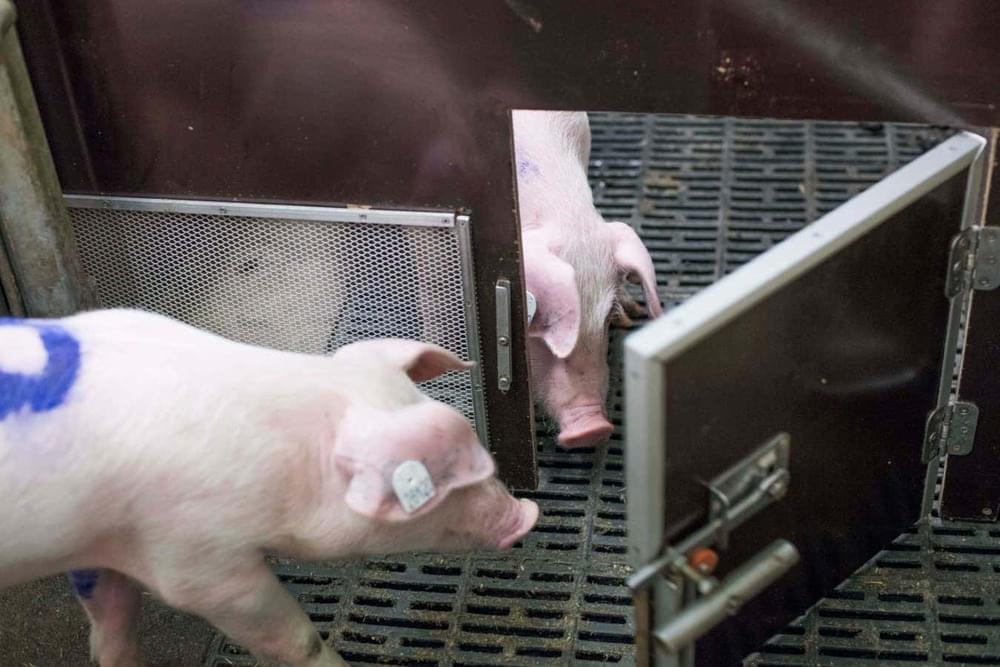An experiment in which pigs showed an inclination to help other group members suggests they have an altruistic streak – but selfish motivations can’t be ruled out.
By Carissa Wong

An experiment in which pigs showed an inclination to help other group members suggests they have an altruistic streak – but selfish motivations can’t be ruled out.
By Carissa Wong

The discovery of the Higgs Boson in 2012 represented a major turning point for particle physics marking the completion of what is known as the standard model of particle physics. Yet, the standard model can’t answer every question in physics, thus, since this discovery at the Large Hadron Collider (LHC) physicists have searched for physics beyond the standard model and to determine what shape future physics will take.
A paper in The European Physical Journal H by Robert Harlander and Jean-Philippe Martinez of the Institute for Theoretical Particle Physics and Cosmology, RWTH Aachen University, Germany, and Gregor Schiemann from the Faculty of Humanities and Cultural Studies, Bergische Universität Wuppertal, Germany, considers the idea that particle physics may be on the verge of a new era of discovery and understanding in particle physics. The paper also considers the implications of the many possible scenarios for the future of high-energy physics.
“Over the last century, the concept of the particle has emerged as fundamental in the field of physics,” Martinez said. “It has undergone a significant evolution across time, which has opened up new ways for particle observation, and thus for the discovery of new particles. Currently, observing a particle requires its on-shell production.”
Join us on Patreon! https://www.patreon.com/MichaelLustgartenPhD
Discount Links:
NAD+ Quantification: https://www.jinfiniti.com/intracellular-nad-test/
Use Code: ConquerAging At Checkout.
Epigenetic Testing: https://trudiagnostic.com/?irclickid=U-s3Ii2r7xyIU-LSYLyQdQ6…M0&irgwc=1
Use Code: CONQUERAGING
At-Home Metabolomics: https://www.iollo.com?ref=michael-lustgarten.
Use Code: CONQUERAGING At Checkout.
At-Home Blood Testing: https://getquantify.io/mlustgarten.
Oral Microbiome: https://www.bristlehealth.com/?ref=michaellustgarten.
The visionary CEO says his companies could one day offer hope to amputees by giving them a prosthetic limb that could one day be better than a biological one.


“My hope is that this finding will encourage materials researchers to consider that, under the right circumstances, materials can do things we never expected,” Demkowicz concluded.
The study is published in the journal Nature.
Self-healing metals are an exciting area of research in the field of materials science. The term refers to metals that have the ability to heal themselves after being damaged or degraded.

A consortium of scientists has just published an atlas of remarkable images of three human organs, each vital in their own way, showing how cell types are arranged and interact.
The result: Glittering, kaleidoscopic blueprints lit up by fluorescent dyes that reveal new intimacies about our bodies and reshape our understanding of human biology and disease like never before.
As you can see in the diagram below, researchers generated the cell atlases in three ways.
Duke University professor Sultan Meghji joined ‘Fox & Friends Weekend’ to discuss artificial intelligence and scientists’ latest efforts to combine the technology with brain cells. #foxnews.
Watch more Fox News Video: http://video.foxnews.com.
Watch Fox News Channel Live: http://www.foxnewsgo.com/
FOX News Channel (FNC) is a 24-hour all-encompassing news service delivering breaking news as well as political and business news. The number one network in cable, FNC has been the most-watched television news channel for 18 consecutive years. According to a 2020 Brand Keys Consumer Loyalty Engagement Index report, FOX News is the top brand in the country for morning and evening news coverage. A 2019 Suffolk University poll named FOX News as the most trusted source for television news or commentary, while a 2019 Brand Keys Emotion Engagement Analysis survey found that FOX News was the most trusted cable news brand. A 2017 Gallup/Knight Foundation survey also found that among Americans who could name an objective news source, FOX News was the top-cited outlet. Owned by FOX Corporation, FNC is available in nearly 90 million homes and dominates the cable news landscape, routinely notching the top ten programs in the genre.
Watch full episodes of your favorite shows.
The Five: https://www.foxnews.com/video/shows/the-five.
Special Report with Bret Baier: https://www.foxnews.com/video/shows/special-report.
Jesse Watters Primetime: https://www.foxnews.com/video/shows/jesse-watters-primetime.
Hannity: https://www.foxnews.com/video/shows/hannity.
The Ingraham Angle: https://www.foxnews.com/video/shows/ingraham-angle.
Gutfeld!: https://www.foxnews.com/video/shows/gutfeld.
Fox News @ Night: https://www.foxnews.com/video/shows/fox-news-night.
Follow Fox News on Facebook: https://www.facebook.com/FoxNews/
Follow Fox News on Twitter: https://twitter.com/FoxNews/
Follow Fox News on Instagram: https://www.instagram.com/foxnews/

In a ground-breaking experiment, researchers from the University of Groningen collaborated with their peers from Nijmegen and Twente universities in the Netherlands, and the Harbin Institute of Technology in China. Together, they confirmed the existence of a superconductive state that was first predicted in 2017.
Their findings, which demonstrate evidence for a unique form of the FFLO superconductive state, were recently published in the journal Nature. This breakthrough has the potential to be impactful, particularly within the field of superconducting electronics.

The study also confirmed past research showing that superagers have a greater volume of gray matter associated with memory in parts of the brain.
In an editorial commentary accompanying the study, researchers Dr. Alexandra Touroutoglous, Dr. Bonnie Wong, and Dr. Joseph M Andreano of Harvard Medical School said this finding primarily focused on the medial temporal lobe of the brain, “which is consistent with previous research.”